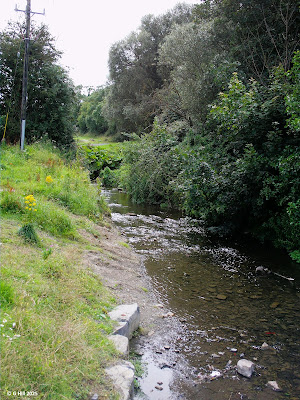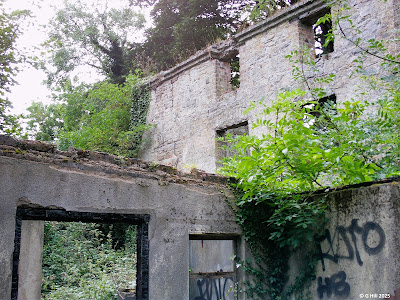Above Image: The Camac River
Above Image: Oil Mill gate pillar
Above Image: A warning.
Above Image & Below 3 Images: Within the ruins
Hidden in the North Eastern corner of Corkagh Park surrounded by bushes and overgrowth lie the remains of a once productive oil mill opened circa 1850 and run by two enterprising gentlemen named Joseph Henry and Peter McNally. The mill concentrated on the production of linseed oil which was produced from seeds of the flax plant. In Ireland flax was usually sown in May and then gathered in August. The mill was powered by the adjacent River Camac. Alongside the mill building was a house with a yard and a mill pond. Operations there ran for 40 years until they finally ceased in 1890. Subsequently the buildings fell into a ruinous state and were left abandoned.
We located the mill after we parked in St. John's car park just off Fonthill Road within the perimeter of Corkagh Park. Our first indication of the mill's whereabouts was a single gate pillar with a notice reading "Oil Mill" which was just across the small stone "Lyric" bridge crossing the River Camac.
A short walk down the lane and we spotted the ruins on our left. They were surrounded by some trees and a lot of overgrowth. Coupled with that the local authority have erected a somewhat stark and ugly metal fence in order to keep people out as the ruins are considered unsafe by the County Council.
We ventured further in amongst the overgrowth following the fence trying to get a closer look until we found part of it broken away. One of the fence posts contained a daubing with the warning "enter and you will die". Ignoring that, we managed to get inside to what was probably part of the house attached to the mill, which is now in a severe state of disrepair. The remains of the mill building loomed above us but it was difficult with the overgrowth to make much progress. The area within was littered with the remnants of some youthful nocturnal imbibing. Since our visit it seems the doorways have now been blocked up.
Such a shame that this building is not protected more although I have heard whispers that the local council is engaging an assessor with a view to a conservation programme. Fingers crossed.
To find the ruins take the R113 Fonthill Road North towards Clondalkin and pass through the crossroads at Boot Road. Continue on and take the second left hand turn onto St. John's Grove. After a short distance you will find a small roundabout. Take the second exit for entry to the Park's car parking area, On the North Western end of the car park take the small lane and cross the small stone bridge. Follow the laneway marked by the Oil Mill gate pillar. You will come across the ruins a bit further down on your left.
Map Reference: 53.317511, -6.411362



















































